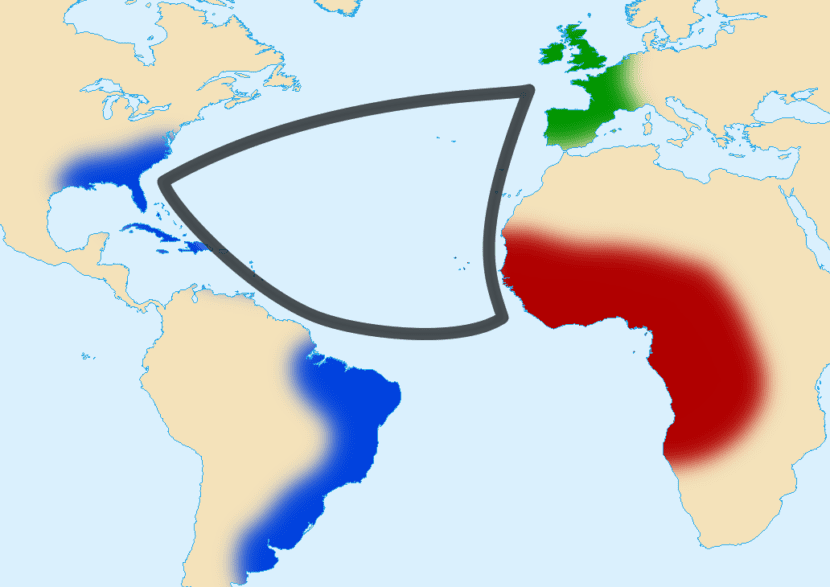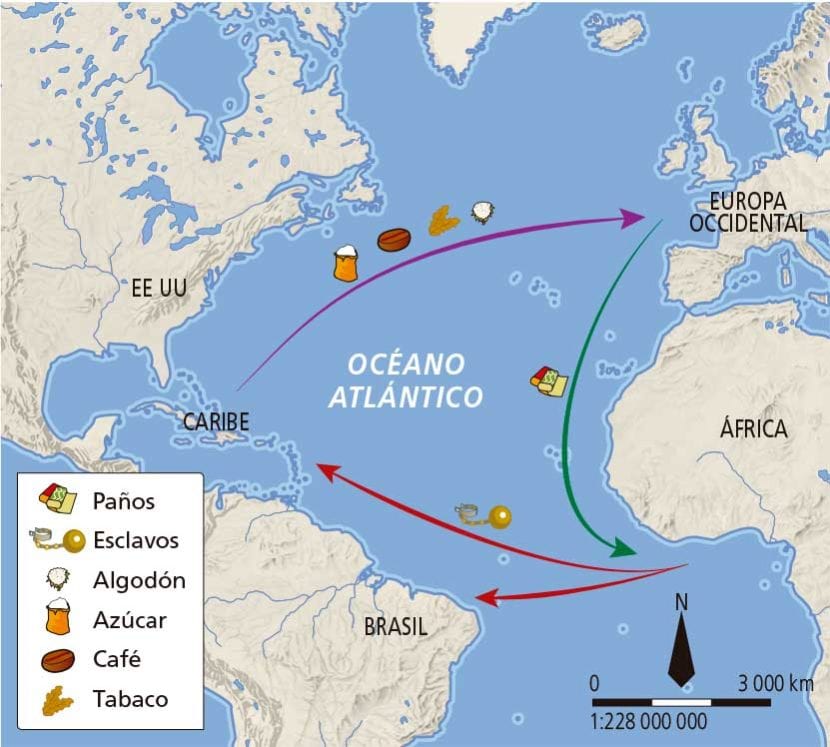
An extensive historical phenomenon, a commercial route established in the Atlantic Ocean, functional from the XNUMXth to the XNUMXth century, this and more was the triangular trade.
In this article we will give a vision of the past that could be contrasted with the present, allowing us to analyze a large-scale event with global significance that still has repercussions today.
This event takes its name due to the triangle shape he drew on the map its orientation, route and geographic dimensions; involving three continents.
Would this type of phenomenon and the planning of its transoceanic routes decisively influence the current world economy?
Today we can say that the modern world economy is essentially a consequence to a great extent of the European voyages of discovery made in the XNUMXth and XNUMXth centuries.
The importance of trade between countries became relevant even before triangular trade began, located at that time on different continents.
Looking back at history

Since ancient times, almost immemorial, slavery has existed in various forms and types, in one way or another it has always been present in the dynamics of life of the human race, subjugating and oppressing.
Romans, Greeks, Babylonians or Egyptians, used as slaves to multitudes in conquered towns; on many occasions individuals who did not pay their debts or simply because they were framed in the category of barbarian peoples; considered inferior and deserving of such actions towards them according to the philosophy of life and analysis of millions of people.
In the Middle Ages the networks of Arab tracks emerged that were destined for the transfer of slaves from central Africa, the network of the Nile, that of the great lakes and other regions.
When America is discovered by the West, the Indian trade is established on a colossal scale. Portuguese and Spanish as early as 1493 divided the New World, and a disproportionate approach began to exploit these regions.
In many of these geographical areas, particularly in the Antilles, the populations were decimated as a result of the wars typical of these events, the diseases that had been imported from Europe and, in general, as a result of the abuse and mistreatment to which they were exposed. in a brutal way.
A workforce that was robust, abundant and cheap was urgently needed, due to the need to exploit the lands in America, its silver and gold mines, plus all the promising scenario that could be perceived in different economic aspects.
There were already recommendations to procure African slaves, whose energetic nature was well known, and would give guarantees of responding to the forced and extreme labor that was planned and recognized should be done.
During the next century, the English also undertake their gallop, targeting the American colonies, followed by some European nations such as Denmark, France and the Netherlands. In 1685, Colbert normalized slavery and the first Black Code was proclaimed, making slavery largely official in this way.
It was then possible to say that the phenomenon of slavery, whose primary influence in this context had an effect on the Indian community first and later on the African, was changing its nature.
With a vertiginous development the “triangular trade” is developing, the slave trade.
Captured and sold are women, men and children. The important and relevant figure of 25-30 million people is the managed number of human beings who were forcibly removed from their territories, without entering into this calculation the innumerable deaths on ships and in confrontations in capture processes and related wars, which they would add greater numbers of affected human beings.
Triangular Trade: A Three-Way Journey
Triangular trade began primarily in Western Europe, in countries such as France, Holland, England and Portugal, with various supplies and manufactures, reaching the west coast of Africa between the Senegal and Congo rivers, where then products such as mirrors, cheap fabrics, bells etc., were used to be exchanged. Once there, black slaves were loaded, supplied by local merchants and elites.

With a nearby stopover in the islands of the Antilles or on the American coast, European slaves and merchandise were sold, loading the ships back to Europe with products such as precious metals, cocoa, tobacco and sugar.
This pattern of trade across the Atlantic, which was prevalent shortly after discovery, and continued until the outbreak of the American Civil War, it involved in a summarized way the following aspects.
- Develop the export of slaves from the African continent to the New World. Already on American soil, the enslaved groups were forced to work in fields producing cotton, sugar and other types of basic products.
- Export to Europe of the basic products produced and raw materials. Many of the goods were traded under different commercial models and also took part in manufacturing processes.
- Part of the production of manufactured products from the implanted dynamics, were exported to Africa, where they were traded with them and the payment of slaves was made.
The route had technical and performance advantages for maritime vessels, given the cellular circulation of winds and ocean currents existing around the Azores anticyclone.
This practical navigation knowledge was possible to be adapted and exploited, after the discoveries in the field of Geography that occurred at the end of the XNUMXth century.
In this type of trade there was a continuous search for efficiency in the operations and general logistics of the process, trend that is currently maintained in trade at a global level and in those that determine and develop it.
A single ship was capable of completing the entire circuit from Liverpool carrying spirits, weapons, and textiles; heading to key points on the West African coast, this being the primary stop. The second stage of the route then began, making the crossing through the Atlantic Ocean loaded with slaves bound for the Antillean Islands or the American coast.
Once in this destination, the slaves were traded and the ships were loaded again with tobacco, cotton, sugar, etc., returning to the original port.
Although this was basically the philosophy of triangular trade, opting for specialization was a trend once the first trips were made. It was a trade of so much volume and value that it was totally rational to build ships that would cover each leg of the journey in a specialized way.
In any case, the term "triangular trade" was the ideal to represent the tripartite exchange that was achieved of slaves, manufactures and raw materials; without having to consider exactly the form of transport and its specific characteristics.
A commercial relationship of this level and type had a significant impact with far-reaching consequences on the differential economic development of the affected areas.. In this way, "colonial trade" was exemplified, the metropolis benefiting from the added value of the industrial production it possessed, the colony being subject to the colonial pact mechanism, with a captive market function.
Damaging at great levels, and plunging the African continent into centuries of economic backwardness and political chaos, slavery was tremendously damaging to this region of the planet. Later, formal colonization followed with the so-called division of Africa in the XNUMXth century, when the slave trade had been abolished on a global scale, the devastating effects not being remedied even after the decolonization of the XNUMXth century.

At the time that triangular trade was developing, as in the present, there was pressure to lower costs by increasing quality, causing important determinations and decisions to be made.
The intercontinental links were even more extensive than those reflected in the graphical representation of the three sides of the triangle. Asia as the fourth continent was included in the expeditions, since the textiles that were exchanged for slaves in the African region came precisely from India, from there they were exported by French and British companies that were established in the area.
It is observed in this behavior or commercial strategy framed within the triangular trade, similarities with the current trade.
Nowadays, internationally successful companies and entrepreneurs in the textile sector turn to Asian countries to establish their productions, obtaining benefits in different areas such as cheap labor costs, application of less demanding regulations than in their countries of origin, a considerable proximity to the sources of the raw materials that will be used, and not infrequently of a higher quality than those found in other regions.
Today it is possible to observe a global complexity in the economic sphere, which is a reflection in itself of the type of exchange at large levels and scale that triangular trade possessed in its time.
One of the great differences existing today, related to global trade at that time; it has to do with the flow of information.
The advances of today's technological tools, the internet and data flow, give facilities to trade actors at a global level so that they can possess and process a level of information that facilitates decision-making and the possibility of minimizing risks. , with astonishing precision.
Putting into perspective and inspired by what triangular commerce was and its influence on modern commerce, makes us wonder With what transformations will the foundations of the new commercial exchange models that will take place in the future be laid today?